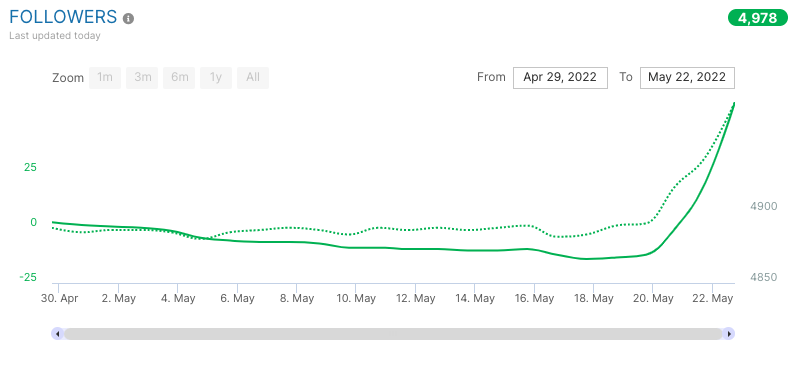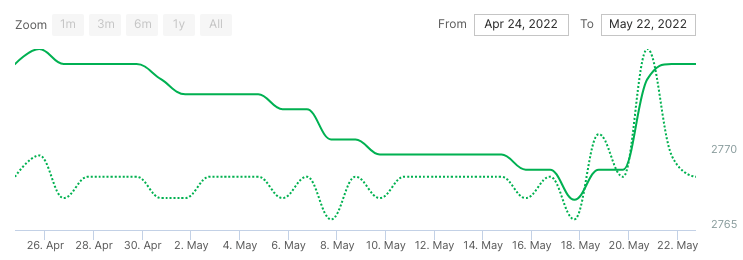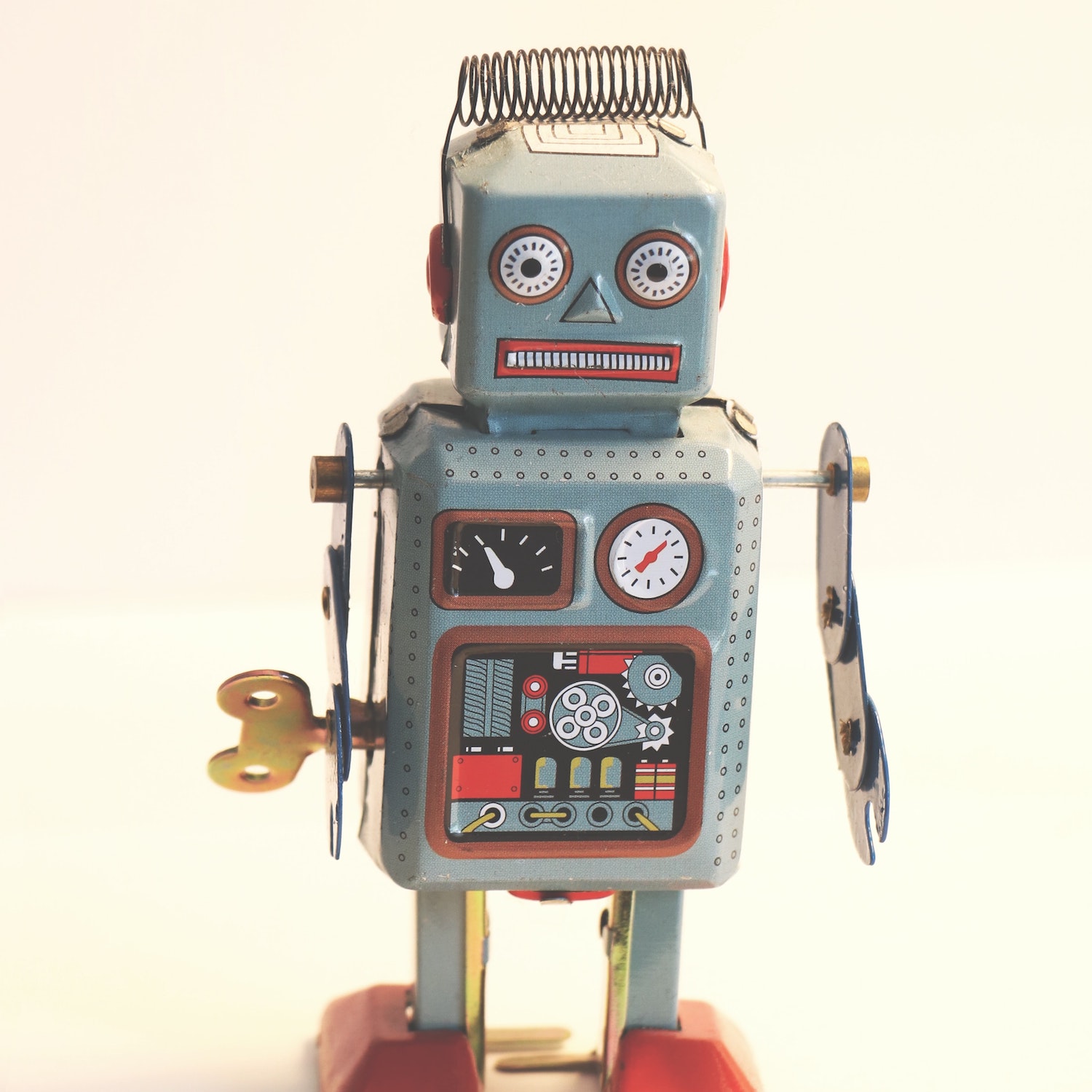TL;DR – Here are the four signs of bots on a Spotify playlist:
- Weird stream-to-follower ratios.
- Weird cities driving streams.
- Unrelated artists showing in “Fans also like” sections.
- Follower spikes (this is the top one to look out for).
Read on for the details. And, whatever you do, stay safe!
If you ever decide to pay for Spotify promotion, you’ll face two huge risks:
1) The promo company could take your money and do nothing / get no results.
This sucks. Sadly, it happens. (Some companies, like Playlist Push and SubmitHub, are upfront about the fact that it can happen; some companies just take your money and run.)
2) The promo company could place you on playlists that are built with bots.
(“Bots” basically = fake accounts.)
This sucks even more.
Because, at best, getting on botted playlists will jack up Spotify’s perception of your music and crush your chances of getting long-term traction through their algorithmic playlists.
Fake accounts don’t engage naturally with songs, which makes Spotify think your song is bad, which means they won’t show it to real people.
And at worst, getting on botted playlists will get your song banned from Spotify entirely; around 750,000 songs were taken down at the beginning of 2021 due to alleged “fake streams”.
Sadly, there are a bunch of companies that do use botted playlists to promote music.
Scary, right?
But here’s the good news:
It’s actually relatively easy to tell if a playlist is built with bots.
Because bots, by and large, are really dumb. They apparently can’t even check a box…

(Why can’t robots do this? Does anyone know? Seriously, I think it’s a weird test.)
…so they have virtually no shot at generating realistic streaming behavior.
I’m not being facetious.
Botted playlists always leave telltale signs.
And the even better news is that you can pick up on these signs before you’re placed on a playlist; you don’t have to wait to see the fake streaming data in your own Spotify for Artists account to determine whether or not a list is legit.
With that said, here are four things to look out for.
1. Weird stream-to-playlist-follower ratios.
To check this, just look at the number of followers listed for the playlist and then click through to the individual artists and songs on the playlists.
If a playlist has 50,000 followers but most of the songs on it have fewer than 1,000 streams, then the list is either incredibly disengaged (nobody is listening to it anymore) or botted.
In either case, you should avoid it.
The same thing goes for the flip side of that ratio. If a playlist has 50,000 followers and all of the songs from smaller artists on it have ~50,000 streams, there’s a decent chance the streams are fake.
(Admittedly, over-streaming is harder to spot from the outside. But if you see that most of the artists on the list have virtually no streams apart from their one song that was placed and that the artists weren’t “Discovered On” any other playlists, it’s a decent sign that the list is bad.)
It’s tough to nail down exactly what a good stream-to-follower ratio should be – I’d say anywhere from 1% to 25% is sensible, with more engaged lists being more preferable – but it’s easy to see when things are really wacky.
Avoid lists with ratios that are way out of wack.
2. Weird cities get streaming credit.
This one takes a bit of digging, too.
If you’re considering submitting to / being placed on a playlist, then take the time to identify a handful of “small artists” on the playlist – artists who haven’t racked up a ton of streams yet.
Scroll down to their “About” section and click in to see where they’re getting streams from. Fun fact: If their top city is Buffalo, NY, and they’re not from Buffalo, then the list is probably botted.
For real, this is a thing; apparently a lot of fake accounts are based in Buffalo.
My friend from Buffalo tells me that it’s an okay place – but despite his claims, it’s not exactly the music capital of the world.
If virtually all of the plays are coming from one city – also probably fake.
Avoid these lists.
3. Smaller artists get tagged with weird “related artists”.
Remember, bots aren’t people, and their listening patterns reflect that sad, sad reality.
Here’s what happens: Fake accounts are used for multiple lists / promo activities – and the combos they’re used for don’t really make sense.
Maybe the fake account follows “Soft Acoustic Songs for 2022” and they follow “Thrash Hip Hop”. That weird mix of genres generates confusing data – and so Spotify generates unrelated artists in the “Fans also like” section of smaller artists.
To check for this, click through smaller artists on the list.
If you don’t like the artists you’re seeing in the “related artists” section, then it’s probably best to avoid the list.
4. Fake playlists have follower spikes.
This sign is the #1 top giveaway for a fake playlist.
You can visualize playlist growth by copying a playlist’s URL and pasting it into Chartmetric or isitagoodplaylist.com.
A good growth curve should look like this:

It’s smooth, without spikes (and generally, curving up over time is a good thing, too). That’s normal, natural growth.
A bad playlist, on the other hand, might look like this:

Or, worse, like this:

Dramatic spikes upward tend to represent times when a curator bought followers. (Yes, it’s possible for upward spikes to come from legitimate sources, like ads or random shares – but spikes are fishy.)
Dramatic spikes downward always signify that a list is fake. The only reason for a bunch of followers to disappear is this: Spotify identified and deleted fake accounts.
That’s it, end of story, goodbye, see you later.
You don’t want to get on a list that has a history of housing fake accounts.
When you see spikes, run away as fast as you can.
Final thoughts on fake playlists…
There are plenty of other ways to tell if a list is fake, but a bunch of them involve looking at your own streaming data after you’re already on the list.
That’s kind of a sucky way to figure out if a list is fake, because if you’re looking at your own streaming data, the damage has already been done.
My hope is that the signals above will help you to avoid bad lists in the first place.
That said, I’ll leave you with a quick word of warning:
If you’re submitting to playlists yourself, please run through these checks before you reach out to a curator asking for inclusion.
And if you’re thinking about paying a promo company, I recommend asking for a few sample playlists before ponying up payment.
Basically, just say, “Could you send me some examples of playlists I might get placed on if I work with you?”, then run the lists they send through these checks.
Playlists, IMO, are still the best way to generate streams on Spotify.
Over the last couple of years, over 150.000 artists on Spotify have pitched their music to playlists big and small, opening up a whole world of possibilities for their artistry and reaching a new global audience. There’s no doubt in my mind that getting into Spotify playlists is a crucial step in the career of a musician.
Good playlists rack up streams and get your music in front of a bunch of new ears – but, yeah, bad playlists will absolutely burn you.
Hope these tips help you to avoid the burn. Be careful out there, and good luck.








